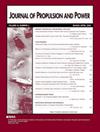Operation and Power Generation of a Disk-Shaped Pressure Gain Combustor
IF 2.4
4区 工程技术
Q2 ENGINEERING, AEROSPACE
引用次数: 0
Abstract
The objective of this experimental study is to evaluate the power generation capability of an ethylene–air disk-shaped pressure gain combustor (DPGC). The main content of this paper focuses on discussing the DPGC testing results, consisting of detonation wave dynamics, power generation, and accompanying combustion instabilities. The experiments can be grouped into two stages. In the first stage, the DPGC was tested under atmospheric back condition. Continuous detonation wave dynamics were evaluated among various testing conditions. Evolution of the detonation wave velocity with respect to changes in the equivalence ratio has been discussed. In the second stage of the experiments, the DPGC was tested with a turbocharger installed. Shaft power extracted by the turbocharger turbine from the DPGC exhaust was used as a metric for evaluating the DPGC power output. During the operation of the DPGC and turbocharger, low- and intermediate-frequency combustion instabilities were observed, which coexisted with the high-frequency component associated with the circumferentially propagating detonation wave. The experimental results suggest that the DPGC shows superiority in compactness relative to conventional combustion power systems. However, more improvements need to be made with regard to overall thermal efficiency in order to achieve the benefits from detonation combustion.盘式压力增益燃烧器的运行与发电
本实验研究的目的是评估乙烯-空气盘形增压燃烧器(DPGC)的发电能力。本文的主要内容是讨论DPGC的测试结果,包括爆震波动力学、发电和伴随的燃烧不稳定性。实验可以分为两个阶段。在第一阶段中,DPGC在大气回流条件下进行了测试。对不同试验条件下的连续爆震波动力学进行了评价。讨论了爆震波速度随当量比变化的演变过程。在实验的第二阶段,DPGC在安装了涡轮增压器的情况下进行了测试。涡轮增压器涡轮从DPGC排气中提取的轴功率被用作评估DPGC功率输出的指标。在DPGC和涡轮增压器的运行过程中,观察到低频和中频燃烧不稳定性,这些不稳定性与周向传播爆震波的高频分量共存。实验结果表明,与传统的燃烧动力系统相比,DPGC在紧凑性方面表现出优势。然而,为了实现爆震燃烧的益处,需要在整体热效率方面进行更多的改进。
本文章由计算机程序翻译,如有差异,请以英文原文为准。
求助全文
约1分钟内获得全文
求助全文
来源期刊

Journal of Propulsion and Power
工程技术-工程:宇航
CiteScore
4.20
自引率
21.10%
发文量
97
审稿时长
6.5 months
期刊介绍:
This Journal is devoted to the advancement of the science and technology of aerospace propulsion and power through the dissemination of original archival papers contributing to advancements in airbreathing, electric, and advanced propulsion; solid and liquid rockets; fuels and propellants; power generation and conversion for aerospace vehicles; and the application of aerospace science and technology to terrestrial energy devices and systems. It is intended to provide readers of the Journal, with primary interests in propulsion and power, access to papers spanning the range from research through development to applications. Papers in these disciplines and the sciences of combustion, fluid mechanics, and solid mechanics as directly related to propulsion and power are solicited.
 求助内容:
求助内容: 应助结果提醒方式:
应助结果提醒方式:


